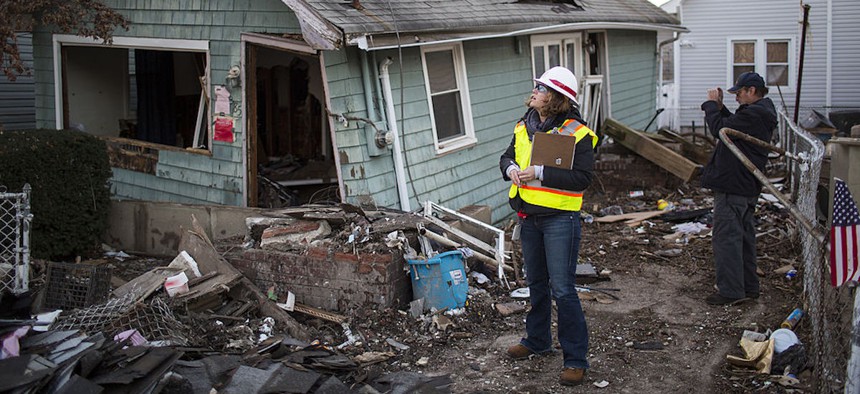FEMA to overhaul its disaster aid system after decades of criticism

A woman with the Army Corps of Engineers and a representative from FEMA document a destroyed home on Nov. 28, 2012, in a residential area of New Dorp Beach in the Staten Island borough of New York City after Hurricane Sandy.. Robert Nickelsberg/Getty Images
The agency will offer upfront cash payments to disaster survivors and slash some of its infamous red tape.
This story is republished from Grist. Read the original article.
As thousands waited on federal government assistance after Hurricane Katrina in 2005, New Orleans residents came up with their own nickname for the Federal Emergency Management Agency, or FEMA. The four letters of the agency’s acronym, they said, stood for “Fix Everything, My Ass.” As climate-related disasters have intensified in the ensuing decades, the agency has been similarly tarred by politicians and disaster survivors from Hawai’i to Vermont.
There are many points of criticism: FEMA seldom provides immediate cash aid to people who lose their homes, instead requiring them to complete onerous housing applications that can take weeks to process. It requires many survivors to apply for and be denied a loan from the Small Business Administration, a separate government agency, before they can get housing aid. It denies them aid if they already have home insurance or if their homes had been damaged before a disaster, and it imposes a mountain of paperwork on people who need to appeal aid decisions or who miss application deadlines.
Now, after decades of inaction, FEMA is addressing those criticisms all at once. The agency announced on Friday that it will fundamentally overhaul the way it delivers aid to survivors, launching new programs to provide quick cash payments to those in need and eliminating much of the bureaucracy that hampers aid access.
“This is really a transformational, deeply impactful, meaningful, and historic change in our provision of individual assistance to survivors of natural disasters,” said Alejandro Mayorkas, the secretary of the Department of Homeland Security, which oversees FEMA. “For too long, in the face of too many natural disasters and extreme weather events, survivors have had to overcome many barriers to access to federal assistance.”
The new rules, which FEMA said are the most significant changes to its aid process in 20 years, will take effect in late March. They don’t require approval from Congress, and will have a minimal impact on federal taxpayers, according to a FEMA official: The reforms will cost about $679 million a year, less than 5 percent of what the agency spent on disasters last year.
The centerpieces of the reform are two new programs that target the chaotic first few days after a disaster strikes. Until now, most agency assistance has come down to victims in the weeks and months following a disaster, after states submit a request for specific types of aid. Once they evacuate the danger zone, victims must apply for assistance with specific costs such as hotel lodging and home repairs.
The first new policy will provide a rapid cash payment of $750 to all victims of federally declared disasters, by direct deposit or check, without states needing to request the money first. The second will give victims flexible upfront funding to cover about two weeks of housing, indexed to housing costs in the region, rather than making them submit long-term housing plans before FEMA will cover their expenses. A FEMA official said the information in those previously required housing plans was “not particularly informative,” suggesting that the upshot of the reform will be a faster deployment of funds.
The reform package will also eliminate some of FEMA’s most notorious red tape. For instance, the agency is doing away with the Small Business Administration loan application requirement, which forced victims who wanted help replacing destroyed personal property to fill out an application they knew would be denied and then present that denial to FEMA. It is also relaxing a rule that prevented residents who had home insurance from getting aid, even if their insurance didn’t cover the full cost of a rebuild. And finally, the agency is eliminating a “pre-existing conditions” provision that prevented residents from receiving aid for housing defects that existed before a disaster, such as leaky pipes or sagging walls.
It will take years for local officials and experts to gauge how these reforms affect the way the United States recovers from disasters, but experts hailed the rule changes, saying they would ease financial and emotional pain for many flood and fire victims.
“These changes put into effect long-standing recommendations to cut red tape and help disaster survivors by implementing quick payments to homeowners,” said Shana Udvardy, a policy analyst at the Union of Concerned Scientists, adding that the reforms “will offer disaster survivors a smoother road to recovery.”
In a press call with reporters, FEMA administrator Deanne Criswell said her administration had been developing the changes for multiple years, and that they are a direct response to previous criticism from survivors, government officials, and the media.
“This has been the result of just listening — listening to all of the concerns that survivors have had, our state and local emergency managers have had, and, frankly, all of you,” she said.





